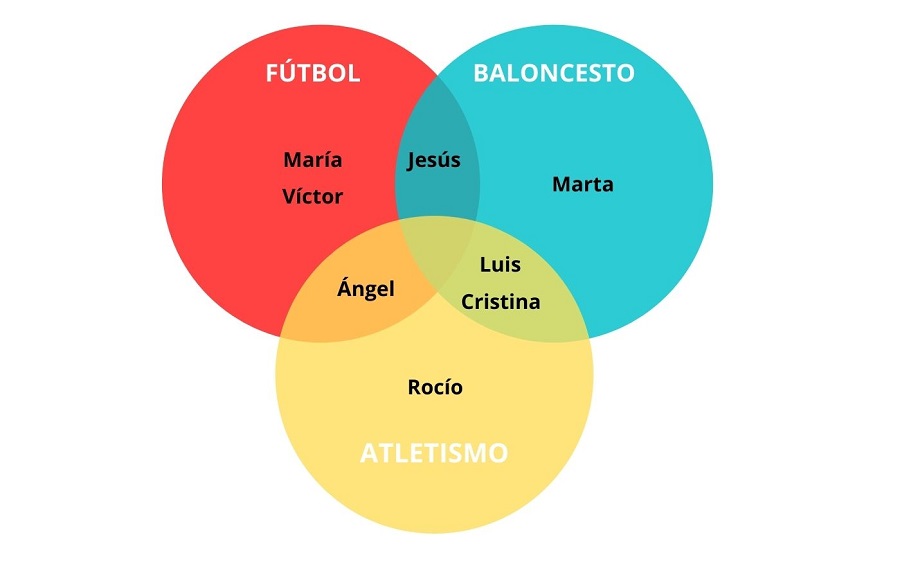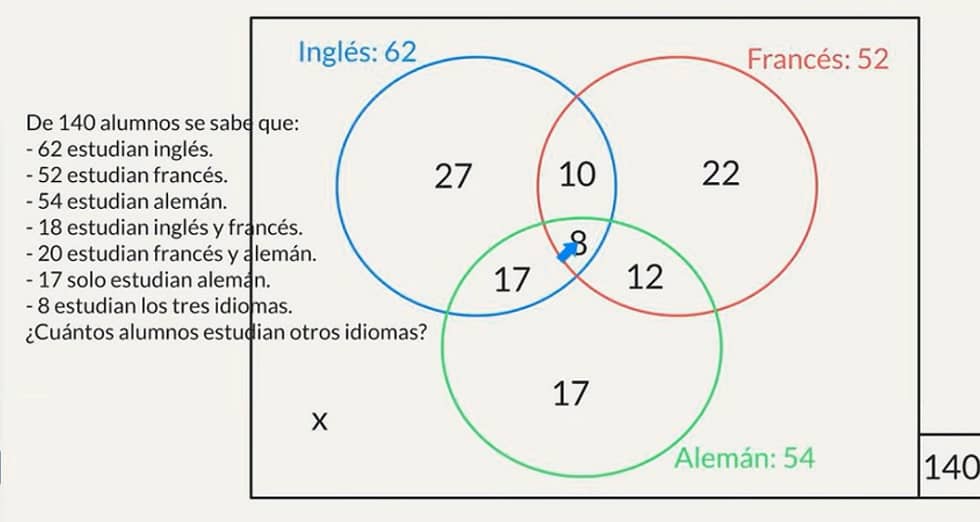Venn Diagram: Definition, Characteristics and Applications

In the vast world of mathematical logic and data analysis, the Venn Diagram emerges as a simple yet powerful tool. This article unravels the mystery behind its apparent simplicity, exploring its distinctive features and practical applications across various fields. From its definition to its most innovative uses, we will delve into the universe of circles that have revolutionized the way we interpret relationships and intersections between sets.
What is a Venn Diagram?
Venn Diagrams, an essential conceptual tool in the field of logic and mathematics, allow for the visualization of relationships between different sets in a clear and understandable manner. But, what exactly is a Venn Diagram? Let's see:
- Basic Definition: In its simplest form, a Venn Diagram uses overlapping circles to illustrate the similarities and differences between sets of elements. Each circle represents a set, and its intersection with other circles shows the common elements.
- Examples of Use:
- In education, to teach logic and mathematics.
- In business, to analyze groups of customers or products.
- In science, to compare characteristics of different species or elements.
This is just the beginning to understand the breadth and depth of Venn Diagrams. Throughout this article, we will explore more about their origins, structure, and surprising uses.
Origins and Evolution: The History Behind the Venn Diagram
Venn Diagrams, also known for their unique features and application in various areas, have a rich and fascinating history. They were developed in 1880 by John Venn, an English mathematician, as a way to graphically represent logical relationships between different sets.
- John Venn and His Inspiration: Venn was inspired by similar ideas of diagrammatic logic proposed earlier by Leonhard Euler, seeking a more intuitive way to illustrate relationships between sets.
- Evolution Through the Years: Over time, these diagrams have evolved, adapting to the needs of various disciplines, from pure mathematics to psychology.
- Recognition and Popularity: Despite their academic origin, Venn Diagrams have gained popularity even in primary education, demonstrating their value in teaching basic concepts of logic and set.
- Variations and Adaptations: Throughout the years, variations of the Venn Diagram, such as Euler-Venn diagrams, have emerged, offering greater flexibility and complexity in representing relationships between sets.
- Continuous Impact in Education and Beyond: The relevance of these diagrams remains notable in the 21st century, adapting to the digital era and maintaining their utility in fields such as computer science, statistics, and data analysis.
| Year and Event | Description |
|---|---|
| 1880 - Creation | John Venn develops the diagram. |
| 20th Century - Expansion | Widespread use in education and science. |
| 1950s - Digitization | Adaptation to the era of computing. |
| 1980s - Innovations | New forms and applications. |
| 21st Century - Current Relevance | Essential tool in data analysis. |
With this historical journey, we can appreciate how a concept born in the 19th century remains fundamental in the information age, demonstrating the timelessness and adaptability of the Venn Diagram.
Practical Applications in Various Fields
Venn Diagrams are not limited to being a theoretical tool; their versatility allows for a myriad of practical applications in different fields. Let's examine some of the most prominent:
- Education: Essential tool for teaching concepts of logic, mathematics, and science.
- Scientific Research: Used to classify and compare data in biological, chemical, and physical studies.
- Statistics and Data Analysis: Help to visualize relationships between different sets of data, facilitating their interpretation.
- Business Management: Useful for analyzing market segments, relationships between products, and marketing strategies.
- Computing and Informatics: Applied in the design of algorithms and data structures.
- Social Network Analysis: To study the connections and interactions between users.
- Psychology: In mapping relationships and human behaviors.
- Art and Design: As inspiration for creative visual structures.
- Personal Organization: Tool for planning and task management.
- Literature and Text Analysis: In the analysis of themes and characters.
These applications demonstrate the ability of Venn Diagrams to adapt to different contexts, making them a multifaceted and valuable tool in numerous disciplines.
Basic Principles: Understanding the Structure and Function
Venn Diagrams are much more than simple overlapping circles; they are a visual representation of mathematical logic and of the relationships between sets. Let's delve into their fundamental elements:
- Representation of Sets: Each circle in a Venn Diagram represents a set, whether of numbers, people, ideas, or any other element.
- Intersections: The area where two or more circles overlap is the intersection, indicating common elements between the sets.
- Exclusion: The areas that do not overlap within each circle show elements exclusive to that set.
| Aspect | Importance in the Venn Diagram |
|---|---|
| Common Elements | Highlight the similarities between the sets. |
| Unique Elements | Emphasize the differences between the sets. |
| Universal Set | Represents all possible elements in a given context. |
| Subsets | Show the inclusion of one set within another. |
| Complements | Indicate what is not present in a specific set. |
Understanding these principles is crucial for effectively using Venn Diagrams, both in educational and professional contexts. Their simplicity and clarity make them a versatile and powerful tool.
Solved Exercise of a 3-Set Venn Diagram

Comparison with Other Methods: Euler Diagrams and More
When exploring the world of graphical representation of sets, it's essential to compare Venn Diagrams with other techniques like Euler Diagrams. Below, we highlight the key differences and similarities:
- Venn Diagrams vs. Euler Diagrams: While Venn Diagrams represent all possible interactions between sets, Euler Diagrams focus only on existing interactions.
- Specificity: Euler Diagrams are more specific and less abstract, ideal for representing sets with clear and defined relationships.
Exploring further:
- Representation of Relationships: Venn Diagrams are more effective for exploring all possible logical relationships, including hypothetical or non-existent ones.
- Diverse Applications: Euler Diagrams are widely used in fields like biology and computer science to structure complex data.
| Method | Characteristics and Applications |
|---|---|
| Venn Diagrams | Represent all possible relationships between sets. Applications: Teaching logic, mathematics, data analysis. |
| Euler Diagrams | Focus on existing relationships between sets. Applications: Biology, computer science, network analysis. |
This comparison highlights the importance of selecting the most appropriate method for each situation, based on the specific needs for representation and analysis of sets.
Tips for Creating Effective Venn Diagrams
Creating an effective Venn Diagram involves more than drawing circles and labels. It's an art that combines clarity, precision, and aesthetics to convey complex information in a simple way.
- Clarity in Representation: Ensure that each set and its intersection are easily identifiable.
- Precise Labeling: Each circle and area of intersection should have clear and concise labels.
- Use of Colors: Use colors to differentiate sets and highlight intersections, but avoid excess.
A good Venn Diagram not only communicates the data but also facilitates analysis and understanding by the viewer.
- Balance between simplicity and informative detail.
- Adaptation of the diagram to the context and audience.
- Incorporation of visual elements to enhance understanding.
| Aspect | Tip |
|---|---|
| Representation | Clarity and distinction of sets |
| Labeling | Precise and understandable labels |
| Colors | Effective use for differentiation |
By following these tips, you can maximize the impact and effectiveness of the Venn Diagram as a tool for communication and analysis.
Tools for Creating Venn Diagrams
Creating effective and attractive Venn diagrams is essential for their correct interpretation. Below, we present a selection of recommended digital and physical tools for this task:
Recommended Digital Tools
- Canva: An easy-to-use and versatile online graphic design tool. The free version allows access through a Google profile, facilitating the creation of Venn diagrams along with a wide range of visual content.
- Creately: Specialized in the design of graphics and oriented towards collaborative environments, this app allows for intuitive creation of Venn diagrams, with options for comments, downloading, and sharing on social networks.
- Visme: A powerful cloud-based tool for creating Venn diagrams quickly. Although some advanced options are premium, those necessary for basic diagrams are available for free.
- Lucidchart: A platform known for its flexibility and ease of use, ideal for creating complex Venn diagrams.
- Gliffy: Offers a friendly interface and is a good option for those looking for a quick online tool to create diagrams.
- Diagrameditor: A simple and practical option for those who prefer straightforward and uncomplicated tools.
Physical Tools for Venn Diagrams
Though digital tools are very popular, we must not forget traditional options like paper and colored pencils, whiteboards and markers, and recycled materials, which are excellent for a more tactile and participatory approach, especially in educational settings.
Innovative Tools
- Data Analysis Software: Tools like R and Python are crucial for integrating Venn diagrams into complex and advanced statistical analyses.
- Interactive Educational Games: These games promote playful and effective learning by including the creation and analysis of Venn diagrams.
